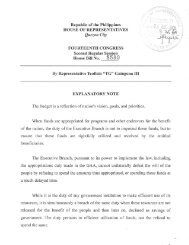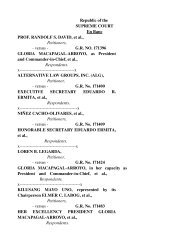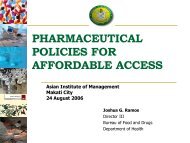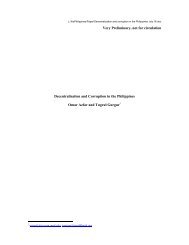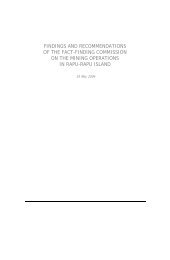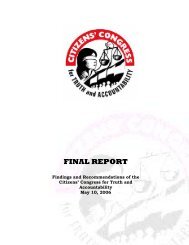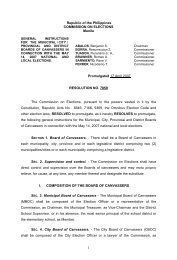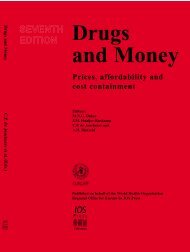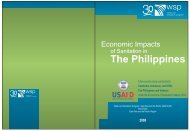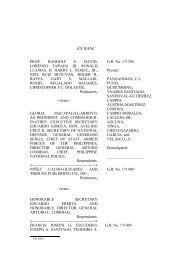i Report Issue No. 3 2005 - Philippine Center for Investigative ...
i Report Issue No. 3 2005 - Philippine Center for Investigative ...
i Report Issue No. 3 2005 - Philippine Center for Investigative ...
You also want an ePaper? Increase the reach of your titles
YUMPU automatically turns print PDFs into web optimized ePapers that Google loves.
RUNNING ON<br />
TAXPAYERS’ MO<br />
LUZ RIMBAN<br />
HOW MUCH does<br />
it cost to become<br />
president? Seasoned<br />
politicians<br />
and political observers<br />
say the<br />
price tag of the<br />
presidency these days could be<br />
anywhere from a low of P2 billion<br />
to a high of P8 billion. That’s<br />
how much is needed to finance<br />
nationwide campaign rallies over<br />
a three-month period, produce<br />
assorted election paraphernalia,<br />
fund multimedia advertisements,<br />
subsidize the campaigns of senatorial<br />
and local candidates, pay<br />
campaign staff, commission surveys,<br />
and, if there’s enough left,<br />
feed election watchers and volunteers<br />
<strong>for</strong> the duration of the count,<br />
which could last <strong>for</strong> weeks.<br />
Where in the world does<br />
anyone get that much money?<br />
<strong>No</strong> wonder the country went<br />
broke after the 2004 polls,<br />
with a fiscal crisis threatening<br />
the economy a mere few<br />
months after the elections. But<br />
then it’s always been that way.<br />
Most incumbents who ran <strong>for</strong><br />
re-election have made Filipino<br />
taxpayers foot their campaign<br />
expenses. In 1969, in what is<br />
still touted as the costliest and<br />
dirtiest of <strong>Philippine</strong> elections till<br />
then, the incumbent Ferdinand<br />
Marcos spared no expense to get<br />
himself re-elected. Massive election<br />
spending that year triggered<br />
a balance of payments crisis and<br />
a currency devaluation.<br />
Fortunately, the 1987 Constitution<br />
banned presidents from<br />
running <strong>for</strong> a second term. An<br />
incumbent, after all, has power<br />
over the government’s vast<br />
organization and resources, including<br />
the funds in the national<br />
treasury intended <strong>for</strong> government<br />
services. He or she there<strong>for</strong>e<br />
has a built-in advantage no<br />
other candidate can equal.<br />
Traditionally, the biggest donors<br />
to presidential campaigns<br />
have been Chinese-Filipino businessmen,<br />
but even they put<br />
together are unlikely to come up<br />
with all the billions needed to fill<br />
a campaign chest. The biggest<br />
donor to the 2004 presidential<br />
campaign could have been none<br />
other than the Filipino taxpayer.<br />
This was where Gloria Macapagal-Arroyo<br />
edged out her<br />
rivals. In the weeks be<strong>for</strong>e and<br />
during the campaign, billions in<br />
government funds were released<br />
as doleouts to local officials,<br />
signaling that the incumbent<br />
was giving out largesse to those<br />
who would support her, amounts<br />
that the opposition could not<br />
possibly equal. Large sums were<br />
also made available in thinlydisguised<br />
projects to promote<br />
Arroyo’s candidacy, including the<br />
dissemination of millions of government-funded<br />
health-insurance<br />
cards (with the president’s photo<br />
imprinted on them), the distribu-<br />
12 PHILIPPINE CENTER FOR INVESTIGATIVE JOURNALISM I REPORT



